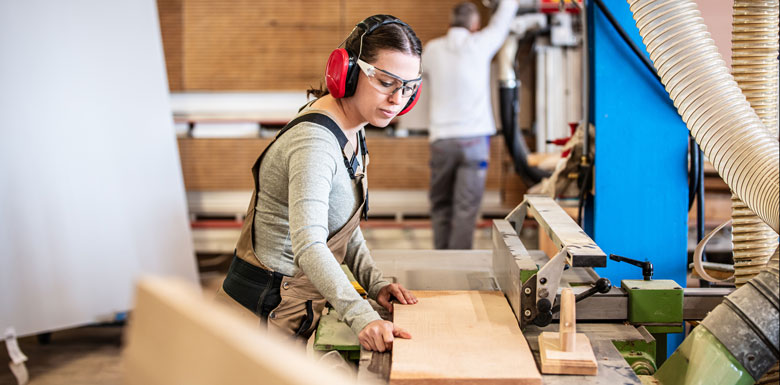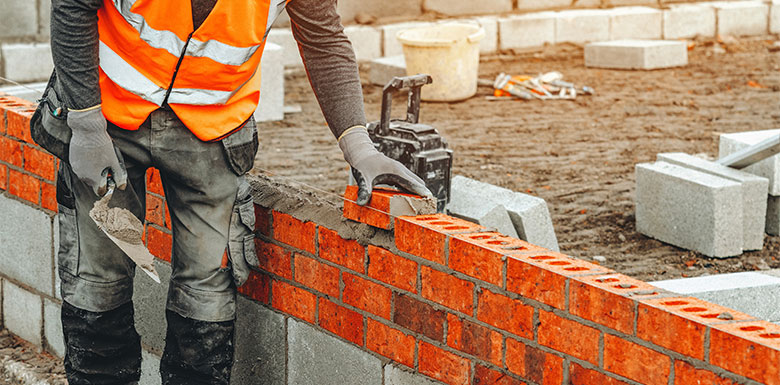Carpentry health and safety
 In this article
In this article
As rewarding as carpentry can be for those working in the industry, it’s also a trade that comes with a substantially high level of risk.
From accidental power tool injuries and sawdust inhalation to the typical slips, trips, and falls that can be experienced in any work environment, the risks associated with working in carpentry make adhering to good carpentry health and safety a fundamental part of risk mitigation.
So, whether you’re new to carpentry, are in need of a refresher, or want to start your own carpentry business in the future, keep reading to learn more about the different carpentry hazards you might come across while you work, as well as tips on how to carry out a carpentry risk assessment, and steps you can take to mitigate the impact of the risks you identify.
What are the main hazards in carpentry to be aware of?
The number of carpentry hazards out there are numerous and varied, with any one project typically including a mix of the following:
- Sawdust and wood chipping inhalation
- Cuts and abrasions from work
- Loose and flying debris
- Falling from heights
- Trips, slips, and falls
- Heavy lifting injuries
- Fire hazards
- Chemical hazards
- Electrocution
- Accidental bodily harm
- Explosions
- Extended exposure to asbestos
- Extended exposure to loud noises
- Long-term health problems, such as hand-arm vibration syndrome
Carpenters may find that they need to update their carpentry risk assessment every few days to account for changes in their working environment or the next stage of their current work project. Doing so is paramount to avoiding potentially serious accidents in the workplace.
How to carry out a carpentry risk assessment
With so many conceivable hazards in carpentry present, you’d be forgiven for thinking that a carpentry risk assessment may be slightly more complicated to carry out compared to a standard one.
However, while perhaps requiring a greater attention to detail than other trades-based risk assessments, you can conduct a carpentry risk assessment in exactly the same manner – namely by taking the following steps:
- Perform a thorough sweep of your working environment and identify as many potential hazards as you can – including those posed by your tools and skill level.
- Once you have your list of hazards, note down the potential result of such a hazard occurring and who or what it may impact – such as too many power tools being plugged in overloading an outlet and causing a fire, which could injure yourself or damage/destroy your workshop.
- Finally, assign a risk level to each hazard and the precautions you’ll take to eliminate or mitigate it as best you can.
From here, you can then begin the process of removing or controlling the risks you’ve identified before moving on to the actual work that needs to be carried out.
Tips for how to carry out a carpentry risk assessment
While it’s all well and good noting the basic process to follow risk-assessing different hazards in carpentry, if you’ve not had to do one before, you might not be sure what to look out for.
Generally speaking, we recommend using your own judgment and being as thorough as you can. But for those who want a place to start, include all of the following in any risk assessment:
- Assess your working environment's layout and ensure that it’s well-organised, with no clear obstacles or structural dangers.
- Check the electrical systems of your work area for any exposed wires, poorly maintained power outlets, water exposure, etc.
- Perform a walkthrough of your current work environment and note any environmental hazards that might be present.
- Examine your tools for any wear-and-tear or accidental damage.
- Double-check that all your PPE is functioning correctly and in a suitable working condition.
- Speak with other tradespeople on-site to compare hazards and build a larger list.
From here, you should have no trouble building a comprehensive list of carpentry hazards to be aware of, and how you intend to deal with them should they occur.
Am I required to carry out a risk assessment?
Yes – as a part of small business employment law, it is a legal requirement for all employers to carry out a workplace risk assessment, regardless of who they are and the industry they work in.
Simply put, not accounting for the risks associated with your line of work can result in serious injury to you and your employees, and potentially lead to legal trouble down the line.
How to minimise hazards in carpentry
Now that you know how to carry out a carpenter’s risk assessment, what are some of the things you can do to eliminate or minimise the impact of any potential workplace hazards you come across?
Below are our tops for how to deal with the most common carpentry hazards:
Working with carpentry tools
No matter the trade you work in, good tool handling is essential for avoiding personal injury, especially when it comes to carpentry. From chisels and hammers to sanding machines and nail guns, there are plenty of carpentry tools out there that can cause serious bodily harm if you’re not careful.
Therefore, it’s important to prep your workspace accordingly to allow space for proper tool handling, removing anything that could interfere with correct tool operation. You should also carry out regular maintenance of all tools, keeping them sharp to prevent slips and jumps during use, as well as addressing any natural wear and tear that might occur.
Finally, when using power tools and carpentry machines, it’s absolutely essential that you follow the correct training and procedures during their use, no matter how experienced you are. These pieces of machinery can be very dangerous, even when inactive, and should be treated with caution at all times.
Minimising environmental hazards
Alongside proper tool use, minimising the potential impact of environmental hazards is an absolute must with carpentry. Your workspace needs to be well-ventilated at all times, or failing that, equipped with a sufficiently powerful ventilation/extractor system capable of removing wood and sawdust.
Likewise, proper PPE is necessary to prevent injury from any chemicals you work with, as exposure can result in serious dermatological conditions or breathing difficulties. Even after use with appropriate PPE, be sure to wash your hands and follow good hygiene to reduce the impact of accidental exposure.
As a rule of thumb, no matter how well-ventilated your workspace is, you should always wear a respirator to minimise the volume of wood and chemical particles you inhale.
Mitigating fire risks
Fire can be a risk in any working environment, but doubly so when working with a material as flammable as wood. Therefore, having fire extinguishers to hand is a necessity for any worst-case scenario, as is a thorough check of all electrical outlets to ensure that they work correctly and won’t overload or spark.
Investing in the right work gear
While we’ve already touched briefly on some of the workwear you’ll need to carry your work out safely, below is a standardised list of workwear you should invest in for proper protection as a carpenter:
- Thick and durable work gloves
- Dust masks and respirators
- Sturdy eye protection
- High-rated ear protection
- Protective headgear
- Protective, well-fitted, and strong work clothing
- Safety shoes with excellent grip
- Harnesses and ropes for fall protection
Other essential things to consider
Last but not least, regardless of whether you’re working in your own personal workshop or on-site, it’s always worth considering the following as additional ways to mitigate workplace risk:
- Maintain a clean work area at all times to keep general hazards to a minimum.
- Have first aid kits close to hand at all workstations.
- Invest in personal or employee first-aid training to ensure there are members of staff on-site who can perform first aid in the event of an accident.
- Formulate a fire evacuation plan for use in the event of a serious fire.
- Carry out regular safety inspections and risk assessments of your place of work and update your risk list with any new hazards you encounter.
- Provide all your employees with the proper training needed to carry out their jobs efficiently and safely.
Grow your reputation as a Which? Trusted Trader
With all of our essential points covered, you should now have a much better idea of what carpentry hazards to be aware of, how to carry out a carpentry risk assessment, and steps you can take to mitigate the potential of these hazards occurring in the workplace.
Demonstrating good health and safety policies will only benefit your business, showing customers that you’re an experienced and reliable business to work with.
But if you want to grow your reputation further, then you should consider becoming a Which? Trusted Trader. By signing up, you’ll be demonstrating to customers that you run a reputable firm capable of delivering excellent service. Not only that but all Trusted Trader members get access to a dedicated account manager and business page to display work and reviews.




